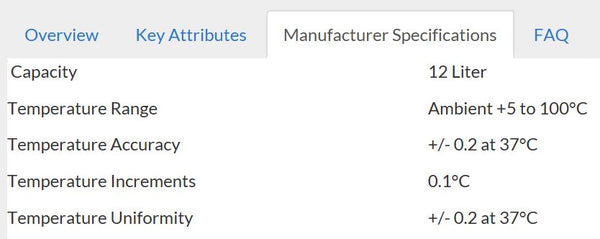When researching equipment that involves important temperature settings, you’ll no doubt come across a variety of terms. Depending on the product you’re viewing, you might see specifications including temperature stability, temperature accuracy, and temperature uniformity. For water baths, you could well see all three.
At first, these might appear to measure essentially the same thing, but there are subtle yet important differences. Depending on the term, it is referring to the ability of the instrument to measure or maintain temperature with a certain precision against a particular reference point.
We’ll look into each specification a bit more in-depth below, but here are some brief definitions:
- Temperature stability measures precision in terms of maintaining a set-point temperature.
- Temperature accuracy conveys how closely readings will match those of a calibrated standard.
- Temperature uniformity measures the potential variation in temperature between different points.
Now we’ll explore each term in some more detail, including some examples.
Temperature Stability
Temperature stability measures the precision of the instrument in maintaining a set-point temperature. For example, you might see a water bath with a temperature stability specification of ±0.1°C.
Manufacturer specifications for the PolyScience Digital General Purpose 5 Liter.
If you set the temperature of this instrument to 35°C, then you can expect the bath to maintain a temperature between 34.9°C and 35.1°C.
Temperature Accuracy
The Merriam-Webster dictionary defines accuracy as “degree of conformity of a measure to a standard or a true value.” In keeping with this definition, when we talk about temperature accuracy, we’re using a standard reference point.
The temperature accuracy of an instrument is how closely its readings match those of a calibrated standard piece of equipment. For example, if you’re wondering about the temperature accuracy of a thermometer, you would need to compare its results to those of a calibrated instrument.
In the context of water baths, temperature accuracy is typically provided as a plus/minus value. It is often accompanied by a certain temperature, the standard being 37°C, since many applications occur at this temperature.
For example, for the water bath referred to below, the temperature accuracy is ±0.2 at 37°C.
Manufacturer specifications for the myBath Series 12 Liter.
So, when the temperature reading states 37°C, the actual temperature could be anywhere between 36.8°C and 37.2°C.
Temperature Uniformity
Temperature uniformity, as you might imagine, refers to the variation in temperature between different points, in this case in a body of liquid. In a water bath, a temperature measurement at one point may give a slightly different reading to one at another point.
Looking back at our last example, you’ll see that the temperature uniformity is often conveyed in a similar format to the temperature accuracy, with a plus/minus value at a particular temperature. In this case, it is ±0.2 at 37°C.


